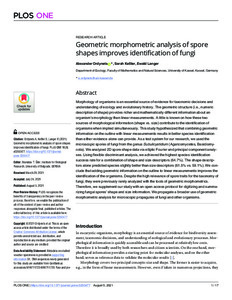| dc.date.accessioned | 2021-10-20T13:03:25Z | |
| dc.date.available | 2021-10-20T13:03:25Z | |
| dc.date.issued | 2021-08-05 | |
| dc.identifier | doi:10.17170/kobra-202110114875 | |
| dc.identifier.uri | http://hdl.handle.net/123456789/13310 | |
| dc.description.sponsorship | Gefördert durch den Publikationsfonds der Universität Kassel | ger |
| dc.language.iso | eng | eng |
| dc.rights | Namensnennung 4.0 International | * |
| dc.rights.uri | http://creativecommons.org/licenses/by/4.0/ | * |
| dc.subject | fungal spores | eng |
| dc.subject | morphometry | eng |
| dc.subject | fungi | eng |
| dc.subject | principal component analysis | eng |
| dc.subject | taxonomy | eng |
| dc.subject | fourier analysis | eng |
| dc.subject | geometry | eng |
| dc.subject | sequence alignment | eng |
| dc.subject.ddc | 570 | |
| dc.title | Geometric morphometric analysis of spore shapes improves identification of fungi | eng |
| dc.type | Aufsatz | |
| dcterms.abstract | Morphology of organisms is an essential source of evidence for taxonomic decisions and understanding of ecology and evolutionary history. The geometric structure (i.e., numeric description of shape) provides richer and mathematically different information about an organism’s morphology than linear measurements. A little is known on how these two sources of morphological information (shape vs. size) contribute to the identification of organisms when implied simultaneously. This study hypothesized that combining geometric information on the outline with linear measurements results in better species identification than either evidence alone can provide. As a test system for our research, we used the microscopic spores of fungi from the genus Subulicystidium (Agaricomycetes, Basidiomycota). We analyzed 2D spore shape data via elliptic Fourier and principal component analyses. Using flexible discriminant analysis, we achieved the highest species identification success rate for a combination of shape and size descriptors (64.7%). The shape descriptors alone predicted species slightly better than size descriptors (61.5% vs. 59.1%). We conclude that adding geometric information on the outline to linear measurements improves the identification of the organisms. Despite the high relevance of spore traits for the taxonomy of fungi, they were previously rarely analyzed with the tools of geometric morphometrics. Therefore, we supplement our study with an open access protocol for digitizing and summarizing fungal spores’ shape and size information. We propagate a broader use of geometric morphometric analysis for microscopic propagules of fungi and other organisms. | eng |
| dcterms.accessRights | open access | |
| dcterms.creator | Ordynets, Alexander | |
| dcterms.creator | Keßler, Sarah | |
| dcterms.creator | Langer, Ewald | |
| dc.relation.doi | doi:10.1371/journal.pone.0250477 | |
| dc.relation.issupplementedby | doi:10.1371/journal.pone.0250477.s001 | |
| dc.relation.issupplementedby | doi:10.1371/journal.pone.0250477.s002 | |
| dc.subject.swd | Pilzspore | ger |
| dc.subject.swd | Morphometrie | ger |
| dc.subject.swd | Pilze | ger |
| dc.subject.swd | Hauptkomponentenanalyse | ger |
| dc.subject.swd | Systematik | ger |
| dc.subject.swd | Harmonische Analyse | ger |
| dc.subject.swd | Geometrie | ger |
| dc.subject.swd | Alignment <Biochemie> | ger |
| dc.type.version | publishedVersion | |
| dcterms.source.identifier | eissn:1932-6203 | |
| dcterms.source.issue | 8 | |
| dcterms.source.journal | PLOS ONE | eng |
| dcterms.source.volume | 16 | |
| kup.iskup | false | |
| dcterms.source.articlenumber | e0250477 | |


